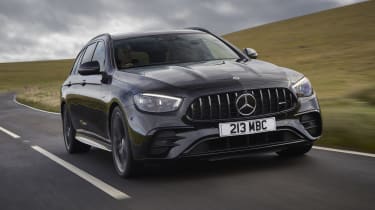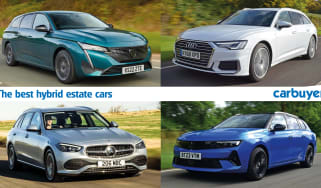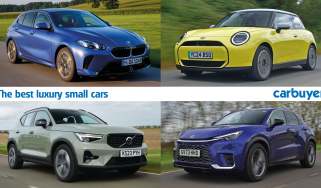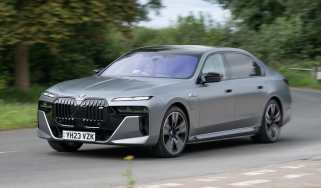Mercedes E-Class Estate - Engines, drive & performance
Comfort is prioritised over sportiness in the Mercedes E-Class estate
The Mercedes E-Class Estate has always focused on being easy-going and relaxing rather than stimulating. However, the latest model is far more rewarding to drive than its predecessors. This is important, since rivals like the BMW 5 Series are fun to drive without sacrificing practicality.
The BMW still has an edge when it comes to fun, but the Mercedes isn’t too far behind. Body lean is more pronounced and there isn’t as much feel through the steering wheel as we’d like. However, the experience it offers still measures up well against the E-Class saloon – the extra bulk of the Estate hasn’t diminished the driving pleasure on offer one iota.
Enthusiastic drivers may be interested in the Mercedes-AMG E53 version of the estate, which is the quickest version in the range unless you go for the hugely powerful but expensive to run E63 model.
We drove a car with Mercedes’ Driving Assistance Plus package. It’s a relatively expensive option but its adaptive cruise control definitely helped to make long journeys more relaxing, and we were pleased to have lane-keeping assist, which actively steers you back in lane on the motorway if you start to drift.
Thankfully we didn’t have to experience the Evasive Steering Assist system, which autonomously swerves the car to avoid a collision. Drive Pilot includes autonomous emergency braking and a feature that automatically lets the car crawl forward when a traffic jam starts to move, but not all of its features are available in the UK: we don’t get its automatic lane change function.
More reviews
UK drivers are unlikely to notice a huge difference in the way 4MATIC four-wheel-drive models drive compared to their rear-wheel-drive stablemates. In very hard driving, it does feel even more securely planted on the road, but you’re most likely to notice the difference in adverse weather, where grip on slippery surfaces is increased. Drivers who want four-wheel drive for any off-road surface more challenging than wet grass will want the Mercedes E-Class All-Terrain.
Mercedes E-Class Estate diesel engines
The 191bhp 2.0-litre diesel E 220 d is likely to be the most popular choice among E-Class Estate buyers. It’s not short of power and pulls strongly, although does become rather loud when worked hard. Its performance lives up to the amount of noise it makes, though – 0-62mph takes less than eight seconds. Staying at a cruise keeps power delivery and gearshifts impressively smooth.
Power is managed by a nine-speed automatic gearbox, with imperceptible gearshifts and immediate response if you suddenly demand extra acceleration. It has different modes to enable the shifts to be tailored according to your mood, but we found it most enjoyable when left in Economy. This gives a relaxing drive with plenty of power at hand.
Upgrading to the 261bhp E 300 d costs around £4,000 but it features four-wheel drive and mild-hybrid electrical assistance. Zero-to-62mph acceleration takes six seconds and it’s the first estate model to get a limited 155mph top speed. Above that is the E 400 d, with a 325bhp 3.0-litre six-cylinder diesel that can power the car from 0-62mph in just 5.3 seconds. The E 300 d and E 400d engines provide a huge amount of pulling power for overtaking and towing.
Petrol engines
There’s one petrol option in the standard engine range: a 194bhp 2.0-litre engine in the E 200 model. Its sub-eight second 0-62mph time is good but Mercedes still seems to be focused on diesel engines in the E-Class Estate.
The Mercedes-AMG E53 uses a 3.0-litre engine that produces 429bhp. That’s enough power to get the car from 0-62mph in just 4.5 seconds, matching the saloon, and comfortably on to a limited top speed of 155mph. It’s assisted by a 48V mild-hybrid system, which scoops up lost energy and uses it to assist the engine, for improved acceleration and fuel economy.
While the E53 is pitched as a performance car, and boasts huge amounts of grip and impressive straight-line speed, there’s no escaping the fact that it’s a big, heavy estate car. While the steering has good weight to it and the car feels relatively agile in corners, the E53 is best thought of as a very fast cruiser; the ride quality and power on offer means it’s capable of eating up the miles effortlessly. It is, however, worth bearing in mind that the E 400 d has plenty of power for this kind of driving, too, and it’ll prove considerably more economical.
If you want your E-Class Estate to offer even more power than the E53 can provide, the even more powerful AMG E63 S model gets 604bhp for 0-62mph acceleration of around 3.5 seconds, but eye-watering running costs make it a niche prospect akin to supercar ownership.
Hybrid engine
The Mercedes E-Class is one of the few cars to offer a diesel-electric plug-in hybrid engine. Most use petrol engines, but the E 300 de is a PHEV for high-mileage drivers, as you can enjoy the efficiency of a diesel on a longer run and a decent electric range when you reach a town. It's no slouch either, as its six-second 0-62mph dash will beat a number of hot hatches.















